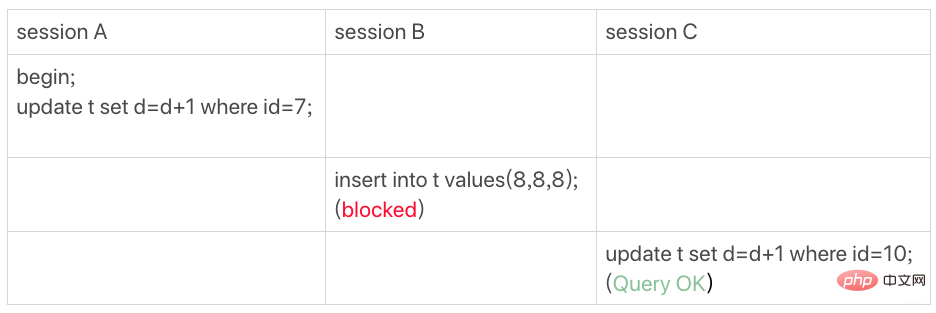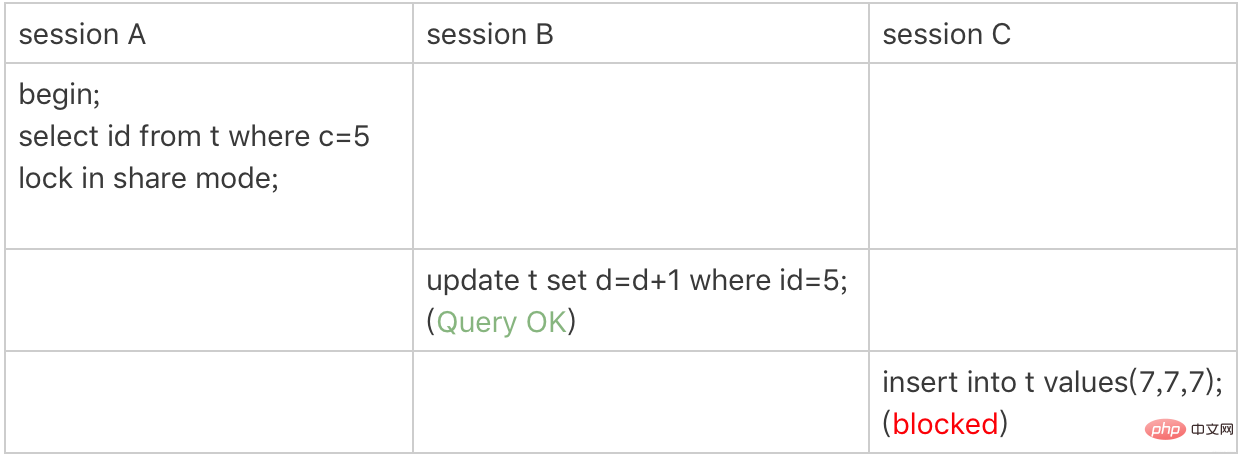
Recommended (free): SQL tutorial
Gap lock plus row lock, it is easy to judge whether An error occurred when a lock wait problem occurred.
Because gap locks are only effective under the repeatable read isolation level, this article defaults to repeatable read.
Lock rules
Data preparation
Table name: t
New data: (0,0,0),(5,5,5), (10,10,10),(15,15,15),(20,20,20),(25,25,25)
The following examples are basically illustrated with pictures, so I recommend You can read it against the manuscript. Some examples may "destroy the three views." It is also recommended that you practice it yourself after reading the article.
Case
Equal value query gap lock
Equal value query gap lock
There is no id=7 in table t, so according to principle 1, the locking unit is next-key lock, so the locking range of session A is (5,10]
At the same time, according to optimization 2, equivalent query (id=7), but id=10 is not satisfied, the next-key lock degenerates into a gap lock, so the final lock range (5,10)
So, if session B inserts the record with id=8 into this gap, it will be locked, but session C can modify the line with id=10.
Non-unique index equivalent lock
Lock only added to non-unique index
session A wants to add a read lock to the row c=5 of index c
According to principle 1, the locking unit is next-key lock, so add next-key lock to (0,5]
c is normal Index , so only the record c=5 is accessed. cannot stop immediately . It needs to traverse to the right and give up only when c=10 is found. According to principle 2, access must be locked, so (5,10] needs to be added with next-key lock
and it also conforms to optimization 2: equivalence judgment, traverse to the right, the last value does not meet the equivalence condition of c=5, so it is degraded Gap lock (5,10)
According to principle 2, only the accessed object will be locked. This query uses a covering index and does not need to access the primary key index, so no lock is added to the primary key index, so session B The update statement can be executed.
But if session C wants to insert (7,7,7), it will be locked by the gap lock (5,10) of session A.
In this example, lock in share mode only locks the covering index, but it is different if it is for update. When executing for update, the system will think that you want to update the data next, so it will give the rows that meet the conditions on the primary key index. Add a row lock.
This example shows that the lock is added to the index; at the same time, it gives us guidance if you want to use lock in share mode to add a read lock to the row to prevent the data from being updated. , you must bypass the optimization of the covering index and add fields that do not exist in the index to the query fields. For example, change the query statement of session A to select d from t where c=5 lock in share mode. You can verify it yourself Here's the effect.
3 Primary key index range lock
Range query.
For our table t, do the following two query statements have the same locking range?
mysql> select * from t where id=10 for update;
mysql> select * from t where id>=10 and id<11 for update;
You may think, id definition Being of type int, these two statements are equivalent, right? In fact, they are not completely equivalent.
Logically, these two query statements are definitely equivalent, but their locking rules are different. Now, let's let session A execute the second query statement to see the locking effect.
Figure 3 Locks for range queries on the primary key index
Now we will use the locking rules mentioned above to analyze what locks will be added to session A?
When starting execution, we need to find the first row with id=10, so it should be next-key lock(5,10]. According to optimization 1, the equivalent condition on the primary key id degenerates into a row Lock, only the row lock for the row with id=10 is added.
The range search continues to search later, and stops when the row with id=15 is found, so next-key lock(10,15] needs to be added.
So, the lock scope of session A at this time is the primary key index, row lock id=10 and next-key lock(10,15]. In this way, you can understand the results of session B and session C. .
You need to pay attention to one thing here. When session A locates the row with id=10 for the first time, it is judged as an equivalent query. When scanning to the right to id=15, the range is used. Query and judge.
Let’s look at range query locking again. You can compare it with Case 3
Non-unique index range lock
| session_1 | session_2 | session_3 |
|---|---|---|
| select * from t where c>=10 and c<11 for update; | ||
##insert into t values(8,8 ,8);(blocked) | ||
| ##update t set d =d 1 where c=15;(blocked) |
c is a non-unique index next-key lock of c.
Unique index range lock bug
The first four cases use two principles and two optimizations, and then look at the locking rule bug case.
| session_3 | ||
|---|---|---|
|
|
||
| where id=20;(blocking) |
|
|
|
insert into t values(16,16,16);(blocking) |
session1 is a range query |
| begin; | delete * from t||
|---|---|---|
|
|
##insert into t | values(13,13,13);(blocking)|
|
When traversing session1, first access the first c=10: |
According to principle 1, add (c=5,id=5) to (c=10,id=10) next-key lock |
session_2
| begin; | delete * from twhere c=10 limit 2 |
|---|---|
|
| # #insert into t values(13,13,13);(blocking) |
The above is the detailed content of shock! There are so many locks in one SQL statement.... For more information, please follow other related articles on the PHP Chinese website!